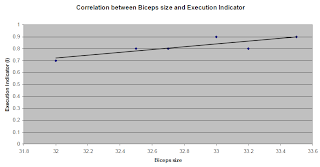This post is a little different from what you normally find on this blog. This time I'd rather invite you to read a study on your own, than to summarize the main findings. The study (
Ivan. 2010) was done by a group of Romanian scientists and published recently in the
Body Building Science Journal. What is particular interesting about the authors' approach is that they try to capture "effective" training methods in physical/mathematical equations. The main ideas behind their quantitative analysis is the following:
Indicators for measuring the quality characteristics of exercises
The level of quality is analyzed using the following indicators:
- the number of repetitions for each exercise;
- the number of sets included in each training program;
- the way in which the athlete executes the exercises taking into consideration the correct position in each key stage of the execution;
- the weights used for each exercise.
Based on these indicators, grades are given for each exercise like very good, good, satisfactory and unsatisfactory. Based on these grades, a trainer or referee evaluates and differentiates the athletes. Depending on the deviations from the correct execution, the corresponding grade is given.
Their results confirm the concept that form is key to muscular development. The way the scientists present their data unfortunately obscures their findings.
 |
| Figure 1: Correlation between biceps size and execution indicator. |
The graph in figure 1, for example, would have appeared much more impressive, if the authors had decided to present just the relevant part, i.e. y-axes values from 0.6-1.0. In that case the linear regression would have been much steeper and nobody would have hat to have a second look at the data to accept the conclusion that...
The quality of an exercise influences the obtained results. The higher the execution quality the higher the results obtained by the athlete. Based on the execution quality, an aggregated indicator was defined, that is able to estimate the growth of arm size of an athlete. This indicator is very useful for athletes in order to estimate the arm size over 1 to 6 months of training.
There are other interesting details in the study as well, so go ahead and
have a look.



